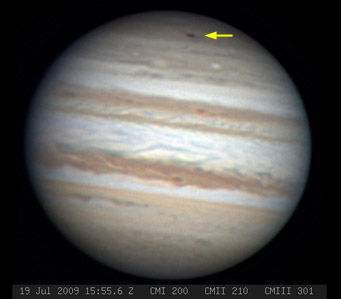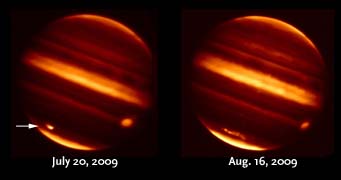On July 19, 2009, thousands of amateurs were converging on China and thereabouts with just one astronomical thought in mind: seeing a total eclipse of the Sun three days later.

Taken on July 19, 2009, Anthony Wesley's image of Jupiter shows a dark marking strikingly similar to the ones left when Comet Shoemaker-Levy 9 crashed into Jupiter in 1994. South is up.
Anthony Wesley
But the cosmos threw us all a curve that day, when Australian astrophotographer Anthony Wesley spied a dark smudge near Jupiter's south pole. Apparently something had slammed into the giant planet for the first time since Comet Shoemaker-Levy 9's celebrated death plunge in 1994. Astronomers at several observatories dropped everything to try to record as much detail of the unexpected impact event as possible before the ashes faded from view.
It's taken a while, but two articles in this month's Icarus detail what infrared observers learned in the days and weeks following the impact. In one report, Leigh Fletcher (Oxford University) and others describe spectra obtained with the Gemini South telescope on July 24th, five days after the blast. Although the impact site looked dark to the eye, it glowed brightly in the infrared, indicating that stratospheric gases at the impact site were still slightly warm (by a few Kelvins).

Images images obtained from NASA's Infrared Telescope Facility in Mauna Kea, Hawaii, show warm debris in Jupiter's atmosphere (arrow) that lingered after an object — apparently a small asteroid — hurtled into the atmosphere on July 19, 2009. The Great Red Spot glows at lower right in each frame. Click here for a larger view.
NASA / IRTF / JPL / Univ. of Oxford
Fletcher's team concludes that the colliding object delivered at least 200 trillion trillion ergs of energy, the kinetic punch that would have come from a body 230 to 1,600 feet (70 to 500 m) across. Apparently it penetrated deeply enough into the planet's cloud decks to dredge up some 7 million tons of ammonia. But the Gemini spectra also reveal that a soot rich in iron, silicate minerals, and silica lay atop the stratosphere as well — hardly the make-up expected from a comet.
Similar conclusions appear in the second report, which details near- and mid-infrared observations from NASA's Infrared Telescope Facility in Hawaii and the Very Large Telescope in Chile. In fact, because he was already at the IRTF when Wesley sounded the alarm, Glenn Orton (Jet Propulsion Laboratory) was able to scrutinize the warm welt within 18 hours of the impact. Orton and others conclude that the unfortunate interloper was 200 to 500 m across, and the spectra likewise indicate the presence of silicates and silica (SiO2).
The silica is the real smoking gun, so to speak. It wasn't detected during the much more energetic Shoemaker-Levy 9 impacts — and it strongly suggests that 2009's whack was from a small asteroid, not a comet. And that possibility has piques the interest of solar-system dynamicists. They'd assumed that only comets crossed paths with the giant planet — in fact, there's a whole class of these icy bodies known as Jupiter-family comets.
"We weren't expecting to find that an asteroid was the likely culprit in this impact," notes Paul Chodas in a JPL press release. But a little dynamical digging has turned up asteroids with unstable orbits that could make close brushes with Jupiter.
You might recall that the teams were still chewing on their 2009 images and spectra when Jupiter was hit once again, this time not even hard enough to leave a mark, last June 3rd. If this keeps up, the good folks at the IAU's Minor Planet Center will have to come up with some kind of interplanetary scorecard to keep track of what got hit and when.
 2
2
Comments
Josh Barnes
February 1, 2011 at 12:28 am
Surely it's time to create a global network of automated telescopes to continuously monitor Jupiter -- and other solar system objects. The technology to do so is widely available, and the results would be fascinating.
You must be logged in to post a comment.
Michael C. Emmert
February 4, 2011 at 6:03 pm
Thank you for posting, Josh Barnes. We might get a clearer picture of the collision frequency in the Solar system as a whole, in addition to being able to sample more kinds of objects. But would an automated system have picked this up? Somebody has to report it before the big 'scopes can be called in.
It's probably not a Trojan asteroid because we expect them to be icy. It could easily be a burnt-out comet. But most likely it had entered an integer resonance, like 1:2 or 1:3 or 2:3 or something like that.
I thought of something while typing this: could an automated system examine the space AROUND Jupiter or other gas giants? If it's not looking at swirling clouds, maybe a machine could get a trajectory of something coming in.
You must be logged in to post a comment.
You must be logged in to post a comment.